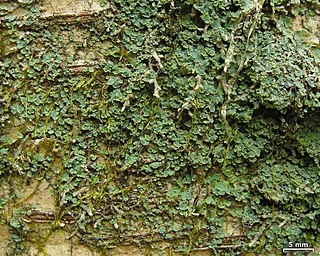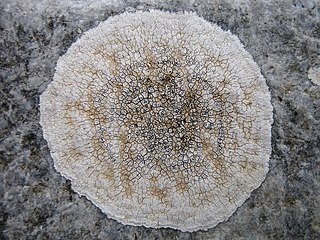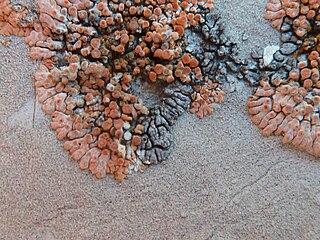
The Verrucariaceae are a family of mostly lichenised fungi in the order Verrucariales. The lichen-forming species, which comprise the vast majority of the family, have a wide variety of thallus forms, and include crustose (crust-like), foliose (bushy), and squamulose (scaly) representatives. Several characteristics of the spore-bearing structures, the ascomata, define the family, including their perithecioid form–more or less spherical or flask-shaped, with a single opening and otherwise completely enclosed by a wall. There are several dozen lichenicolous (lichen-dwelling) examples in the family, and a few genera that contain solely lichenicolous members. An unusually wide variety of photobiont partners have been recorded, mostly green algae, but also brown algae and yellow-green algae.

Dermatocarpon is a genus of lichens in the family Verrucariaceae.
Clavascidium is a genus of lichens in the family Verrucariaceae. The genus was circumscribed in 1996 by Austrian lichenologist Othmar Breuss. Because the type species of the genus, Clavascidium umbrinum, has been shown using molecular phylogenetics to belong to genus Placidium, Cécile Gueidan and colleagues proposed to unite Clavascidium with Placidium in a 2009 publication. Despite this, the genus has been retained in recent publications of fungal classification.

Catapyrenium is a genus of lichens in the family Verrucariaceae. The genus was circumscribed by German botanist Julius von Flotow in 1850.

Thelidium is a genus of lichen-forming fungi in the family Verrucariaceae. The genus was circumscribed in 1855 by Italian lichenologist Abramo Bartolommeo Massalongo, who assigned Thelidium amylaceum as the type species.

Normandina is a genus of lichen-forming fungi in the family Verrucariaceae. It has three species:
Stenocybe is a genus of fungi in the family Mycocaliciaceae. It has 14 species.

Hypocenomyce is a genus of lichen-forming fungi in the family Ophioparmaceae. Species in the genus grow on bark and on wood, especially on burned tree stumps and trunks in coniferous forest. Hypocenomyce lichens are widely distributed in the northern hemisphere.

Phacopsis is a genus of lichenicolous (lichen-dwelling) fungi. They are parasites of members of the large lichen family Parmeliaceae, of which they are also a member. Originally proposed by Edmond Tulasne in 1852 to contain 3 species, Phacopsis now contains 10 species, although historically, 33 taxa have been described in the genus. Many of the species are poorly known, some of them having been documented only from the type specimen.

Varicellaria is a genus of crustose lichens. It is the only genus in the family Varicellariaceae.

Hydropunctaria is a genus of saxicolous (rock-dwelling), crustose lichens in the family Verrucariaceae. The genus includes both aquatic and amphibious species, with members that colonise either marine or freshwater habitats. The type species, Hydropunctaria maura, was formerly classified in the large genus Verrucaria. It is a widely distributed species common to littoral zones. Including the type species, five Hydropunctaria lichens are considered marine species: H. adriatica, H. amphibia, H. aractina, H. orae, and H. oceanica.

Circinaria calcarea is a species of crustose lichen in the family Megasporaceae. It was first described as a new species by Carl Linnaeus in his 1753 work Species Plantarum. Linnaeus named it Lichen calcareus, as he classified all lichens in the eponymously named genus. The species has had an extensive taxonomic history, resulting in dozens of synonyms. In 2010, it was placed in its current genus, Circinaria, following molecular phylogenetic analysis of the Megasporaceae.

Verrucula is a genus of lichenicolous (lichen-dwelling) lichens in the family Verrucariaceae. Species in the genus are parasitic on saxicolous (rock-dwelling), crustose lichens, including Xanthoria elegans as well as lichens from genus Caloplaca that contain chemical substances called anthraquinones.
Atla is a genus of crustose lichens in the family Verrucariaceae. It has nine species that grow on rocks or on soil.
Halospora is a genus of lichenicolous (lichen-dwelling) fungi in the family Verrucariaceae. Species in the genus parasitise calcicolous crustose lichens, i.e., those that prefer lime-rich substrates.

Mastodia is a genus of lichen-forming fungi in the family Verrucariaceae. It has six species. The genus was circumscribed in 1847 by Joseph Dalton Hooker and William Henry Harvey. The type species, Mastodia tessellata, is a bipolar, coastal lichen. It forms a symbiotic association with the macroscopic genus Prasiola; this is the only known lichen symbiosis involving a foliose green alga. Studies suggest that throughout its geographic range, the lichen comprises two fungal species and three algal lineages that associate.
Atla recondita is a rare alpine species of saxicolous (rock-dwelling), crustose lichen in the family Verrucariaceae. Found in Sweden, it was formally described as new to science in 2015 by Sanja and Leif Tibell. The type specimen was collected from Hamrafjället at an altitude of 1,075 m (3,527 ft); there, it was found growing on calciferous rocks. It is known only from a few locations in this area, collected at an altitude range between 610 and 1,075 m. The lichen has a thin olive brown-coloured thallus and ascospores with 9–15 transverse septa and 3–4 longitudinal septa. The authors note that it is not possible to distinguish this species from the similar Polyblastia by morphology alone.
Atla praetermissa is a species of saxicolous (rock-dwelling), crustose lichen in the family Verrucariaceae. Found in Scandinavia, it was formally described as a new species in 2008 by Sanja Savić and Leif Tibell. The type specimen was collected in Andersjöåforsen. In addition to Sweden, it has also been recorded in Norway; it grows on calcareous rocks near streams, at altitudes ranging from 165 to 955 m. The lichen has a superficial, thin and sometimes mesh-like, crustose thallus that is grey to dark green, sometimes with a brownish tinge. Its ascospores are narrowly ellipsoidal and measure 44.7–49.2 by 19.0–22.4 μm. Atla praetermissa has an unidentified green alga as a photobiont.
Hydropunctaria rheitrophila is a species of freshwater, saxicolous (rock-dwelling), crustose lichen in the family Verrucariaceae. It was formally described as a new species in 1922 by German lichenologist Georg Hermann Zschacke as a species of Verrucaria. Christine Keller, Cécile Gueidan, and Holger Thüs transferred it to the newly circumscribed genus Hydropunctaria in 2009. It is one of several aquatic lichens that are in this genus. The photobiont partner of Hydropunctaria rheitrophila is a yellow-green alga.











